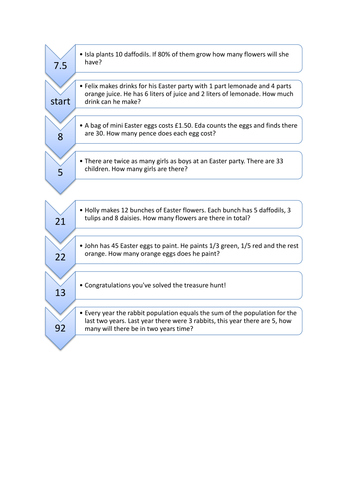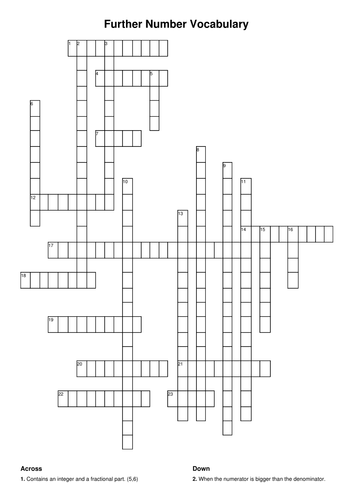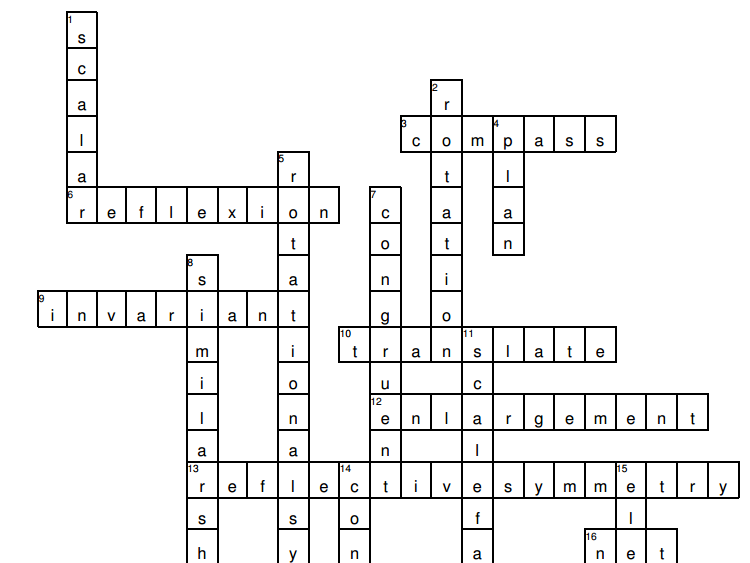
27Uploads
26k+Views
10k+Downloads
All resources

Easter treasurehunt using ratio, number, fractions, percentages
This is a fun end of term resource. Your students will cut out the puzzle pieces and put them in the correct order so that the answer from the first clue gives them the next clue until they have solved all the clues and found their treasure (chocolate eggs not included!).
Students will apply their knowledge of ratio, probability, percentages, fractions and number to solve the clues.
This would be a good activity to do in pairs and you could choose to give a small prize for the quickest team or to every team who solve all the clues.
There are two versions of this treasure hunt, an easy version and a harder one with bigger numbers to allow for differentiation. You could also ask extension questions for further challenge, e.g. Fibonacci numbers are briefly introduced and you could ask students to explore this pattern further.

Further Number Vocabulary Crossword and Word Search
This is a crossword and word search with further number vocabulary. It is aimed at higher tier students and would be useful as
- revision
- lesson starter
- settling activity
- cover work
- end of term activity
- extension task
- literacy support for EAL or SEND students
- literacy across the curriculum
- assessment for learning or afl task
Contains printable pdf and answers for the crossword and wordsearch. For differentiation I have included a wordsearch and a crossword using similar vocabulary. The wordsearch is easier.
The learning objective is to introduce or revise further number vocabulary in a fun and relaxing way.
This activity could be used at the start of a topic to introduce key vocabulary by having students fill out as much as they can independently and then check their answers and fill in the gaps using the answer sheet provided. Once students have all the answers they can save the crossword to refer to during the course as a useful list of vocab and definitions. This would help students with dyslexia to spell the vocab correctly and would enable all students with high language needs to refer back to the definitions as required to allow them to access later lessons. After filling in the crossword students could be asked to annotate the crossword with examples or mnemonics for the vocab to aid understanding and recall.
This activity could also be used for revision where students might complete several crosswords in a lesson or for homework. They would work at their own pace to identify areas where they need focus their revision.
This activity is for teachers, tutors, special needs teachers, teaching assistants, after school club organizers and parents or students looking for revision activities.

Mnemonics for learning students names
Get ready for September by learning these mnemonics for the 100 most popular names of 2004. Most of your new year 7 students will have names on this list (there is considerable overlap with the 2003 list).
We all know that learning students names quickly is key to good classroom management but for many of us it's difficult. By learning these visual mnemonics ahead of time it is much quicker and easier to learn to attach names to faces. Once you have a pre-prepared visual image like "Ben is climbing big ben" you can simply imagine your new student called Ben climbing big ben. Remembering his name is now as easy as remembering this image. Our brains are much better at processing and remembering visual information than names. It makes sense to take advantage of this to learn your students names quickly!
This resource contains a csv file with names in one column and mnemonics in another. Most flash card programs will allow you to import from this format to generate flashcards. For example Anki is free and allows you to import from csv.
These mnemonics are for the 100 most common British names of 2004, helping you to learn your new students names more quickly.
Bundle

Geometry and Measures Crosswords and Word Searches
All my crossword and wordsearch resources on the topic of Geometry and Measure. Between them these crosswords cover the Geometry and Measure terminology students need for higher tier GCSE. I use the AQA spec but other exam boards require very similar vocabulary.

Valentine's Venn Mystery with Venn diagrams and probability
This is a Valentine's themed lesson where the students must figure out who sent the mysterious Valentine's Day cards.
There are 18 cards representing different students who might have sent the Valentine's cards. I recommend getting the students to cut out the cards so that they can easily sort and rearrange the cards later as they solve the puzzles. This could be an independant starter.
The included powerpoint presentation works through an example of selecting students which fit the given criteria using Venn diagrams. This starts with a single circle and progresses to three circles so is ideal for students who have not met Venn diagrams before or are not comfortable with them. Each student name starts with a different letter so that it is easy to write the initials up on the board in the correct circles. Alternatively you could have your students bring up one of the cards they have cut out and blue tac it to the correct section of the diagram. I image this as a full class activity although you could have students copy the diagrams to their books and fill them in individually first.
There is also a set of questions for students to solve independently once they have been shown the idea of Venn diagrams. It is possible to solve the questions without using Venn diagrams and so you may want to ask any students who don't intuitively draw the diagrams to use them for some questions. The probability questions at the end will be generally be easier to keep track of by drawing diagrams.
Finally the presentation includes some independant extension activities for students who finish early so that you can help students who need more support.
Bundle

Maths GCSE Vocabulary Wordsearchs and Crosswords
All my maths GCSE wordsearches and crosswords in one place. Perfect for revising key terminology ahead of GCSEs.







